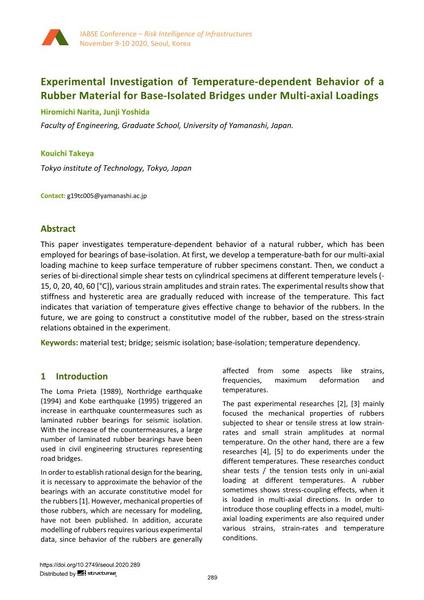Experimental Investigation of Temperature-dependent Behavior of a Rubber Material for Base-Isolated Bridges under Multi-axial Loadings

|
|
|||||||||||
Détails bibliographiques
| Auteur(s): |
Hiromichi Narita
(Faculty of Engineering, Graduate School, University of Yamanashi, Japan.)
Junji Yoshida (Faculty of Engineering, Graduate School, University of Yamanashi, Japan.) Kouichi Takeya (Tokyo institute of Technology, Tokyo, Japan) |
||||
|---|---|---|---|---|---|
| Médium: | papier de conférence | ||||
| Langue(s): | anglais | ||||
| Conférence: | IABSE Conference: Risk Intelligence of Infrastructures, Seoul, South Korea, 9-10 November 2020 | ||||
| Publié dans: | IABSE Conference Seoul 2020 | ||||
|
|||||
| Page(s): | 289-296 | ||||
| Nombre total de pages (du PDF): | 8 | ||||
| DOI: | 10.2749/seoul.2020.289 | ||||
| Abstrait: |
This paper investigates temperature-dependent behavior of a natural rubber, which has been employed for bearings of base-isolation. At first, we develop a temperature-bath for our multi-axial loading machine to keep surface temperature of rubber specimens constant. Then, we conduct a series of bi-directional simple shear tests on cylindrical specimens at different temperature levels (- 15, 0, 20, 40, 60 [°C]), various strain amplitudes and strain rates. The experimental results show that stiffness and hysteretic area are gradually reduced with increase of the temperature. This fact indicates that variation of temperature gives effective change to behavior of the rubbers. In the future, we are going to construct a constitutive model of the rubber, based on the stress-strain relations obtained in the experiment. |
||||
| Mots-clé: |
pont
|
||||
